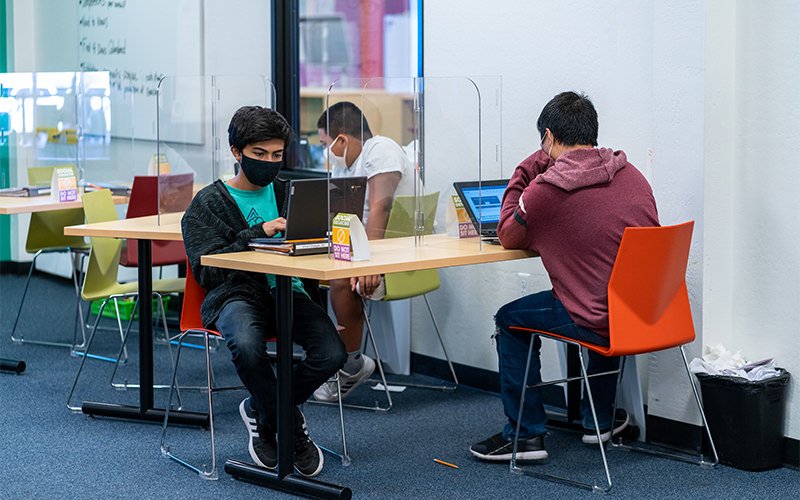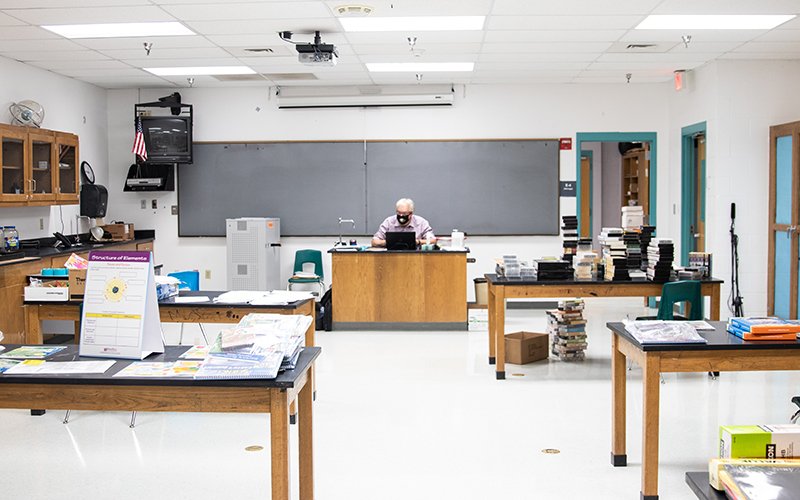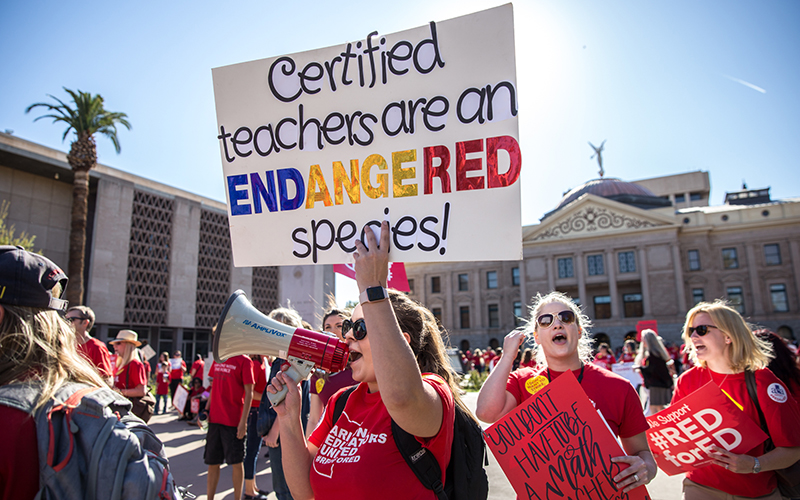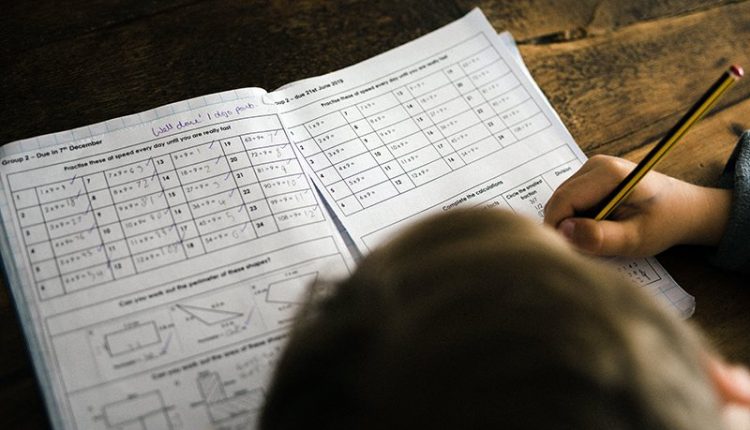As COVID-19 continues, college students battle in Cave Creek district
What makes things more difficult for students in the Cave Creek district is that teachers have left key positions, such as language, math and special-education teachers, middle-school counselor Cadi Angeli says. (Photo by Annie Spratt/Creative Commons)
CAVE CREEK – Students and teachers at the Cave Creek Unified School District returned to in-person classes in early September, joining other schools as petri dishes for how classes could be handled during COVID-19. Weeks later, early results show the struggle – teachers leaving schools over health concerns, students in classrooms led by long-term substitute teachers and parents trying to figure it all out.
Two dozen teachers – about 9% of the district’s 263 certified classroom teachers – have resigned or gone on leave, according to Caroline Lynch, the district’s director of human resources. But not all of those were related to COVID-19, Superintendent Debbi Burdick said.
That’s the most teachers to have left the district in a semester in all of Burdick’s 12 years as superintendent, she said.
“I’m really feeling lucky that we’ve hired two teachers in the last month,” she said. “Because you’re not seeing a lot of people applying, you actively have to go out to the universities or the communities looking for people, so it is a concern.”
The situation in Cave Creek is being repeated in schools across Arizona and the U.S. as administrators, staff members, teachers, parents and – especially – students grapple with how to best learn during a pandemic. They have devised online, in-person and hybrid learning models, each of which has drawn support and criticism.
The Mesa Education Association, which represents about 850 teachers in Mesa Public Schools, the largest in the Phoenix area, called for a halt to in-person classes after Thanksgiving because of coronavirus infections. (All students will start remote next semester.) The Flagstaff Unified School District has elected to continue remote learning through at least the end of the second semester on Jan. 5. Scottsdale Unified had to shutter five schools for a week because of a lack of teachers. And the COVID-19-teacher battle comes in the midst of a challenging climate for teacher hiring and retention.
Cave Creek’s governing board voted to return to in-person classes on Sept. 8, about a month after its official start date of Aug. 5. At a board meeting on Aug. 31, 149 comments were read, with the majority in favor of returning to in-person classes, with students given a choice of in-person or online.
That vote, like every decision school leaders have been forced to make because of the pandemic, has had consequences for some students.
The substitute situation
The situation has become so dire that “we’re running our schools based on the grace of a lot of really good substitute teachers, quite frankly,” said Cadi Angeli, a counselor at Sonoran Trails Middle School.
Even though the substitute teachers at Sonoran Trails are “working their butts off for not a whole lot of pay,” Angeli said substitutes, unfortunately, can’t provide “quite the same education as a student would get with a full-time teacher” because they’re not certified.
Related story

“Kids need continuity, and they know that these teachers are substitutes, so in some cases knowing they have a substitute discounts that teacher’s ability in the student’s mind,” Angeli said. It “isn’t fair but it’s reality.”
Without permanent teachers in every position, some of the district’s nearly 5,500 students have been dealing with a lack of clear direction and less classwork, some parents said.
Emily Pettee, who has a child at Cactus Shadows High School, said she hopes her daughter’s “able to still be challenged” with the way her classes are set up.
“I’m grateful for the subs,” she said. “I’m glad that they’re there, but the quality is not going to be the same.”
Burdick said she’s grateful the district has well-qualified substitutes.
“Many of them have been teachers in their past careers and have retired and agreed to come back to assist in our classrooms,” she said. “I know some have doctorate degrees, so we’re very fortunate up here in the north Valley to have very qualified substitutes and that they’re stepping in at a difficult time to come in and teach in the schools right now.”
Students’ and parents’ stories
Shannon Canales, the parent of a ninth grader at Cactus Shadows High School and a seventh grader at Sonoran Trails Middle School, said her children’s education has been challenged.
Canales said her middle-school child has a long-term substitute for her math class.
“They have a non-math teacher just supervising them in the class,” she said. “So they’re getting no instruction. They’re getting assignments on Canvas and Google Classroom, and they’re being pretty much told to figure it out.”
Although the former math teacher has office hours after school or on weekends to try to help students through the material, “they have absolutely no instruction for their math class,” Canales said.
Because of the lack of direction and glitches with the online software the school has been using, Canales said her middle schooler’s grades have fallen for the first time in her life.
“It’s added stress for her,” she said. “She’s struggling, and it’s made her depressed.
“For the first quarter, her grades were dismal, and it’s not because she didn’t do the work. It’s because they (school officials) weren’t being flexible.”
Burdick said students being assigned work without instruction “is not what we would want to be happening,” but some classes only have substitutes temporarily.
If teachers are out on quarantine, for example, for being exposed to COVID-19 but are not sick, “they would be actually doing the lesson plans for their classes and even assisting students on the side on Zoom or having office hours,” she said.
Classes with long-term substitutes do receive live instruction, Burdick said, because long-term substitutes are paid additional dollars to do so and “expected to do the lesson planning, the grading and teaching,” she said.
Pettee, whose child attends Cactus Shadows, said her daughter has been struggling with honors English because there’s no permanent teacher for her class. She is using the high school’s two online programs because she lives with a family member considered at high risk for contracting COVID-19. She takes her regular classes online and Zooms into her higher level classes.
After her daughter’s honors English teacher “resigned at the end of the first quarter,” Pettee said, the girl missed six days of classroom instruction on Zoom “just because of poor communication between the administration and the new sub.”
“I don’t blame the sub, obviously,” Pettee said. “She’s just trying to do her best to help out, but it just was a real miscommunication issue.”
Although her daughter’s grades have not suffered, Pettee said “my daughter has had a lot less work.”
In the first quarter, before the teacher left, Pettee said she was “so impressed” by the work her daughter was bringing home.
“It really felt much more like a college-level class than high school with the expectations” and focus of the writing, she said. “Now it just seems light.”
She said that even her daughter said she “was concerned about being able to move ahead into 11th grade honors English next year if she doesn’t get the same quality of 10th grade honors English.”
Pettee said the quality of the online classes is “fine, but it certainly isn’t equal to the education that she’d be getting at school.”
That lament is echoing across the U.S.

In schools across Arizona and the U.S., administrators, teachers, parents and students have tried to adjust to online, in-person and hybrid learning models. At Piñon High School on the Navajo reservation, science teacher James Gustafson teaches virtually from his empty classroom. (File photo by Megan Marples/Cronkite News)
The situation for schools in Arizona
Before the school year started in August, the Arizona Department of Health Services and county health officials provided guidelines and benchmarks for measuring the spread of COVID-19, which causes the coronavirus, to help districts and charter schools determine when and how they could safely return to in-person instruction.
Those guidelines came at the direction of Gov. Doug Ducey, who, in his executive order, left the specifics up to Arizona’s 230 school districts and 560 charter schools. Some have taken similar approaches to conducting classes, others are vastly different.
Lori Hart, a journalism and creative writing teacher at Cactus Shadows High School, said she believes the district’s governing board unanimously voted to return to in-person classes immediately because parents wanted their children in school. That decision came despite Burdick’s recommendation to reevaluate returning to classrooms at a later time.
“I think they were really affected by parent comments and people going crazy at home with their kids,” said Hart, who was granted a leave of absence under the federal Family and Medical Leave Act.
Regardless of the reason, Pettee said, as a parent, she believes that asking the teachers to go back to the classrooms so soon was “really a shame.”
“The teachers were put in a very difficult position,” she said. “It’s a failure at the state level because the state should have actually mandated or made some decisions rather than leaving it up to each individual school board of five volunteers.”
Some teachers didn’t feel safe returning
Hart, who has a preexisting medical condition, had to get a lawyer involved to get time off under the Family and Medical Leave Act so she wouldn’t have to go back to teaching in-person classes.
Hart said she thinks she was denied the first time she applied for leave under the 1993 law because, in part, the district was worried about losing teachers.
“I’m sure they were panic-stricken,” she said. “It was a harrowing couple of weeks because I didn’t want to have to quit.”
Hart said she and other teachers are dismayed about not being able to teach.
“We want to come back,” she said. “All of us love teaching. I’ve been teaching for 17 years, and I want to be in the classroom. I miss my students every day, but I didn’t feel safe coming back.”
Hart said she hasn’t personally received any backlash from parents for not returning to the classroom, but listening to the governing board meeting was “so upsetting.”
“It was kind of shocking to hear the complete lack of respect for the teacher position,” she said.
The heartbreak of teacher retention
Angeli, the middle school counselor, said students in the Cave Creek district are having a tougher time because teachers have left key positions, such as language, math and special education.
“Most of the districts are all looking for those same categories of teachers and they’re impossible to find,” Angeli said.
Pettee said “you can’t just put any warm body in to fill these places.”
“They don’t understand how difficult it is for the district to hire quality teachers who can teach these high-level subjects,” she said, referring to some parents. “You can’t just bring in anyone and expect it to be the same quality.”
Not having teachers for every position also adds stress to other teachers, Angeli said.
“The teachers have to pick up the slack,” she said. In addition to potentially having to give up their prep time to cover a class that doesn’t have coverage, teachers are also responsible for helping the subs out.
Teachers aren’t “just planning for their classes,” Angeli said. “They’re also providing lesson plans and curriculum planning for the classes that need coverage.”
Teacher vacancies and retention is growing as an issue in Arizona.
Related story

About 28% of teacher vacancies across the state remain unfilled while half of them are filled by teachers who do not meet the state’s standard certification requirements, according to a September survey by the Arizona School Personnel Administrators Association.
A year earlier, in 2019, the association reported about a 21% vacancy rate.
Teacher retention in Arizona has been problematic, according to a 2017 Morrison Institute report that says 22% of teachers hired from 2013 to 2015 were not teaching in Arizona after one year and that 42% of Arizona teachers hired in 2013 had left the profession within three years.
A 2016 report by the Learning Policy Institute suggested teacher shortages also are a national issue. It estimates there were 64,000 unfilled positions across the country in the 2015-16 school year.
“Unless major changes in teacher supply or a reduction in demand for additional teachers occur over the coming years,” the report said, by 2020, “300,000 new teachers will be needed per year, and by 2025, that number will increase to 316,000 annually.”
Will Cave Creek teachers be allowed to return?
The teacher shortage likely will mean teachers in Cave Creek who left this school year will be allowed to return next school year. The district superintendent will ultimately decide.
Angeli said she assumes the teachers who went on leave or resigned will be welcomed back with open arms next year “because we lost some really, really good ones.”
“Some teachers really did a lot in their school district for many years and if they’re willing to come back, I think the district would be more than happy to take them,” she said.
Burdick said teachers who broke their contract for illness reasons will face no ramifications.
“We would welcome those people back,” she said.


Comments are closed.